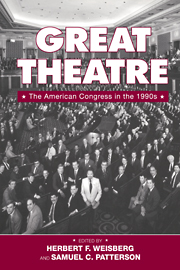1 - Theatre in the Round: Congress in Action
Published online by Cambridge University Press: 20 January 2010
Summary
From across the nation come the representatives of the people – from cities great and small, from towns and hamlets, a few from farms – to gather in the halls of the U.S. Congress. In the House of Representatives, the sergeant at arms installs the mace, a symbol of authority, and the Speaker of the House strikes the gavel to bring the House to order. The chaplain offers the morning prayer, the House approves the journal of the previous day's business, and a member solemnly delivers the Pledge of Allegiance. In the Senate, in a starker, simpler ceremony, the president pro tempore normally calls the assembly to order. On extraordinary occasions, the Senate may be convened by the vice president of the United States. The chaplain prays, the majority leader is recognized to announce the day's legislative business, and then the leader calls for “morning business” so that senators can make prepared remarks on any subject. Thus, the congressional drama begins.
Congress as theatre? That is not how either the public or political scientists usually think of it. Yet the idea of Congress as theatre resonates with people very naturally. Citizens' political socialization may embrace the drama of presidential campaigns more fully than the theatre of congressional politics (Starobin 1996). Nevertheless, both inside and outside the beltway around Washington, D.C., Congress provides plenty of drama for aficionados and the mass audience alike. The media, especially television, more often than not convey negatives about Congress – spawning “a kind of naive cynicism about the theatre – the ancient and necessary conceits – of politics.”
- Type
- Chapter
- Information
- Great TheatreThe American Congress in the 1990s, pp. 3 - 30Publisher: Cambridge University PressPrint publication year: 1998



